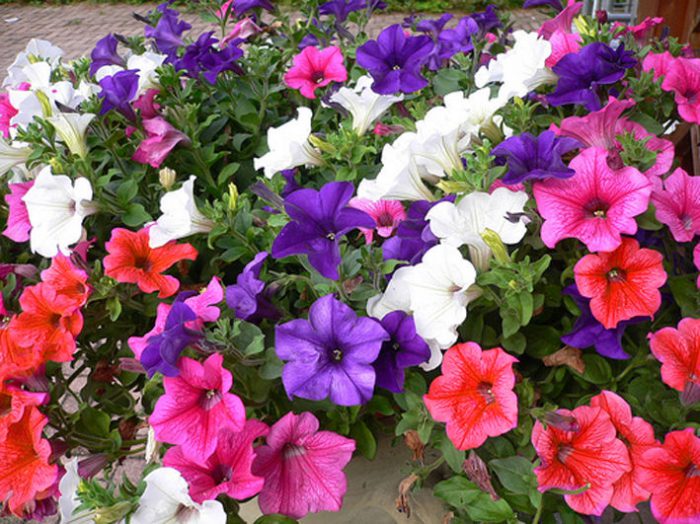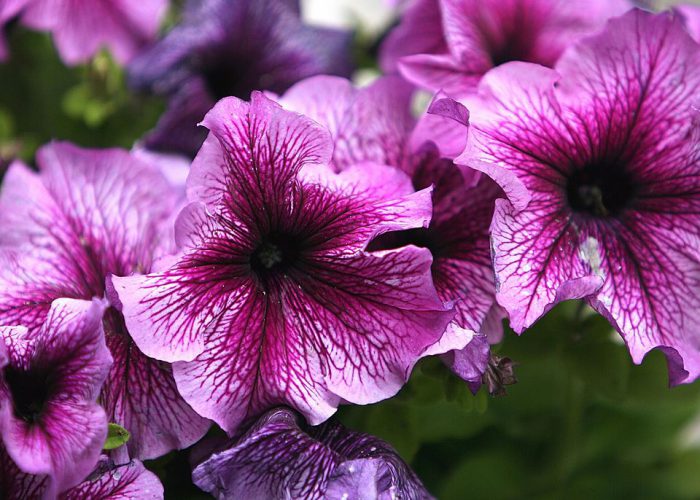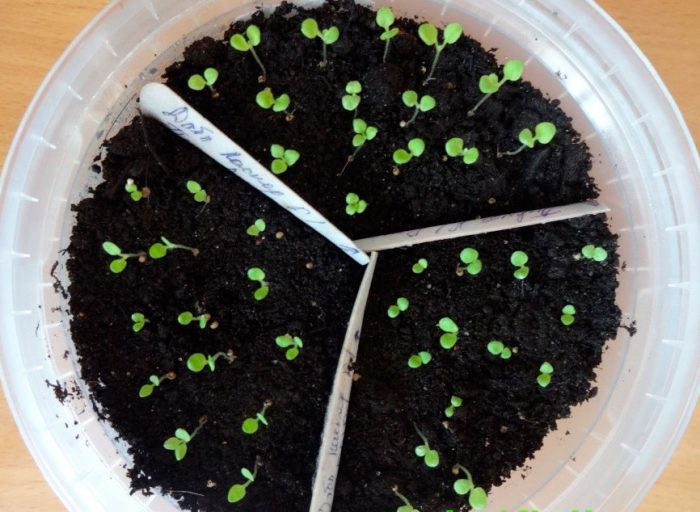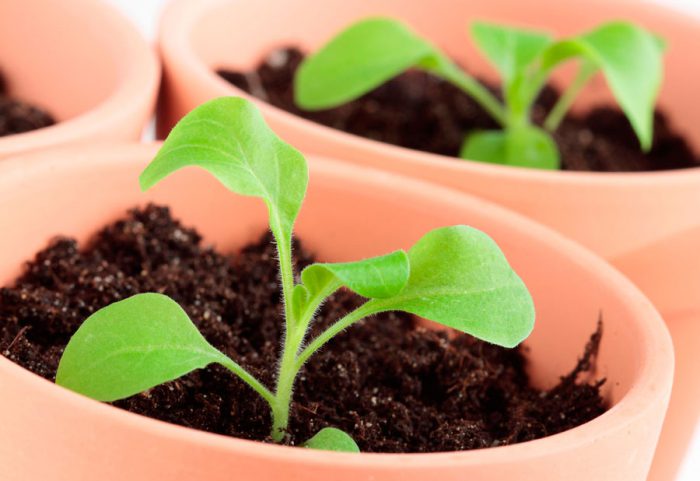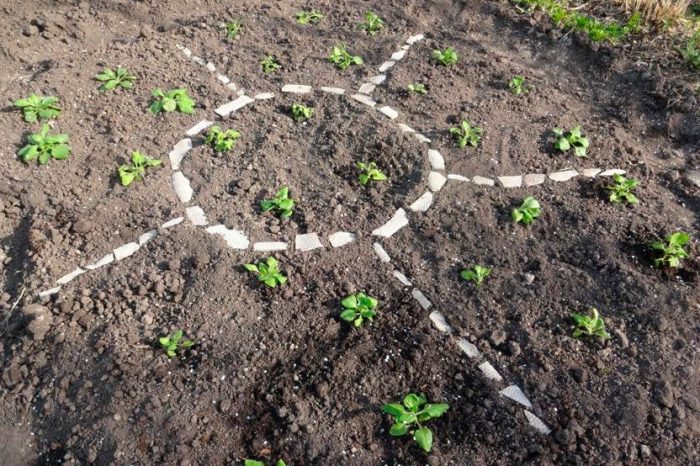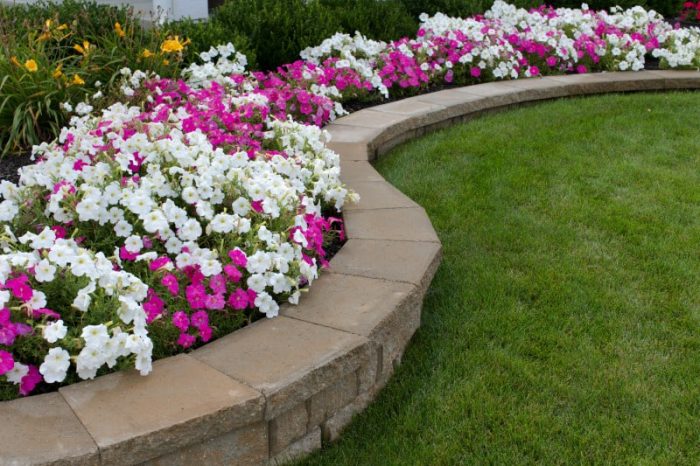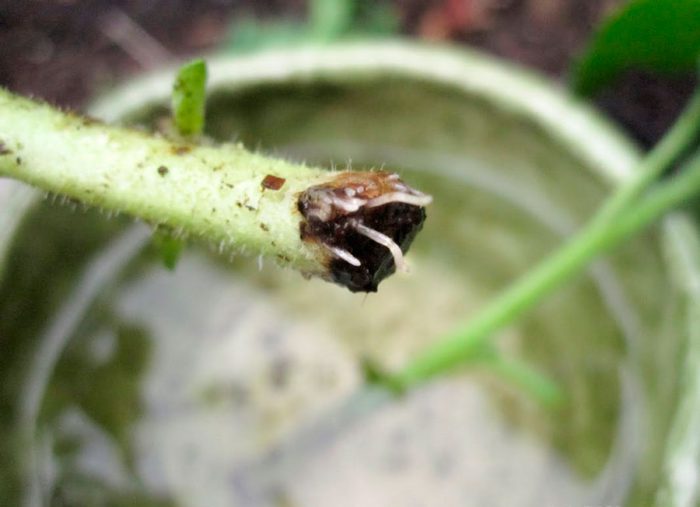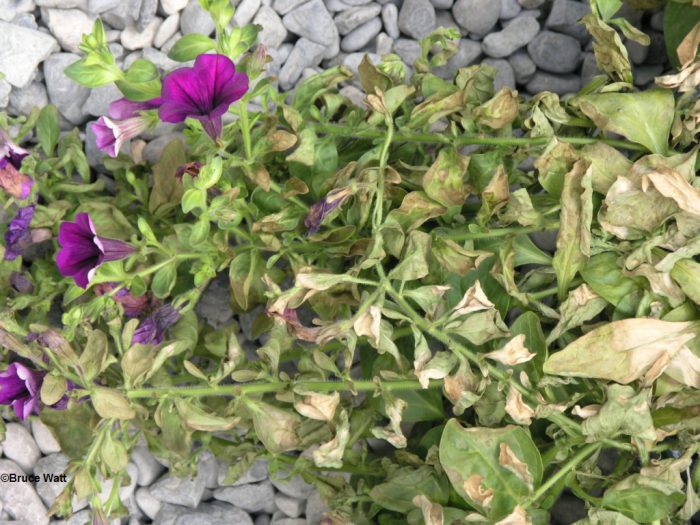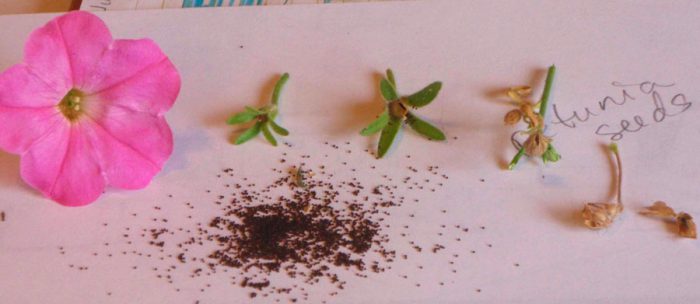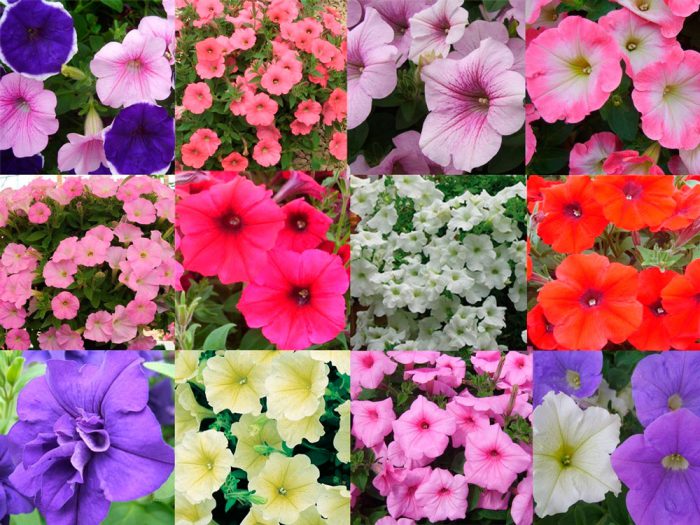Petunia (Petunia), also called petunia, is a genus represented by dwarf shrubs and herbaceous perennials. This genus belongs to the Solanaceae family. In the wild, such a plant can be found in the tropics of Argentina, Uruguay, Brazil, Bolivia and Paraguay. The name of this genus comes from the Brazilian word "petun" which translates as "tobacco". The fact is that tobacco and petunia are related plants. Even in North America, you can meet 1 species of petunia. This genus unites about 25 species. In some cases, these species are very different from each other. Such a plant has been cultivated since the 18th century. Breeders more than a century ago created hybrids that today are grown as garden or balcony annual plants. Petunia is attractive because its lush bloom lasts the whole season, while the flowers are relatively large, bright and very beautiful. Also, this plant goes well with other flowers grown in the garden, for example, with begonia or pelargonium. Ampel petunia in suspended compositions looks very impressive, especially consisting of varieties of various colors. Also, this plant is very popular, because even an inexperienced gardener can grow it.
Content
Features of petunia
The shape of the petunia is bushy. In height, such a flower can reach 0.15-0.7 m, its densely branched shoots can be erect or creeping. Alternate solid oval leaf plates in length reach 5-12 centimeters, they have a dark green or green color. There is pubescence on the surface of foliage and shoots. Single funnel-shaped flowers are located on short peduncles, they can be irregular or regular, terminal or axillary, double or simple, and fringed are also found. Flowers can be purple, pink, blue, pale red, white and violet, with a border, a whitish star, a halo or dark veins. The fruit is a bivalve box with seeds inside.
On balconies and garden plots, varieties of garden petunia (hybrid) are cultivated, which were bred using wild species of axillary petunia and purple petunia. Flowering begins in July and ends with the onset of frost.Perennial petunia is always grown as an annual plant.
Growing petunias from seeds
Sowing
If you sow petunia seeds for seedlings in February, then they will need a backlight. Most gardeners prefer to sow seeds from mid to late March, while it should be borne in mind that due to insufficient daylight hours, seed germination is extremely low, so they must be sown with a margin. The sowing medium should be light, loose and rich in nutrients. The recommended composition of the substrate: rotted humus, peat, sand and sod or leafy soil (2: 2: 1: 2).
Fill the container with the soil mixture, while the top layer 10 mm thick should consist of the sifted substrate. 24 hours before sowing, the soil mixture must be well watered, in this case the seeds can be evenly distributed over its surface. Seeds must be combined with dry sand before sowing. Then they are evenly distributed over the surface of the substrate and moistened with a spray bottle. The container on top must be covered with foil or glass. Crops are harvested in a warm (20 to 23 degrees) place.
After about 7 days, the first seedlings should appear. They will need to be ventilated and moistened from a sprayer 2 times a day every day. It is very important during this period to maintain a high level of air humidity in the mini-greenhouse, however, because of this, a "black leg" may develop on the plants. To prevent this, it is necessary to remove condensation from the film every day immediately after its appearance, and the glass must be turned over the other side. In addition, seedlings must be systematically sprayed with a weak solution of manganese potassium. When the first true leaf plate is formed in the plants, the shelter from the container will need to be removed, the surface of the substrate should be covered with a thin layer of sand, and watering should be reduced.
Seedling care
When the seedlings have 3 or 4 true leaf plates, they should be picked, before that, having thoroughly moistened the substrate in the container. Take the stick and gently pry it on the plant. Pull it out of the soil by grasping the leaves, while being careful not to shake the substrate off the roots. For picking, individual plastic or peat pots are used, which must be filled with the same substrate. After the plants are sown, they need to be well watered and covered with paper sheets or lutrasil for 2-3 days.
During this period, you need to take care of the seedlings correctly and this should be taken seriously. During this period, the substrate should be moderately moist all the time. At this time, a variety of factors affect the frequency of watering, therefore, in one case, the seedlings will need to be moistened 1 or 2 times in 7 days, and in the other - twice a day. It is very important to systematically loosen the surface of the substrate around the plants. 7 days after the pick, the plant will need to be systematically fed once a week, while the root and foliar feeding method should be alternated. For top dressing, you can take Kemira, Nitrofoska, Solution or other water-soluble complex fertilizers, while from 25 to 35 grams is taken for 1 bucket of water.
Grandiflora varieties begin to bloom 3 months after sowing seeds, and multiflora varieties - after 2.5 months. Before you start planting seedlings in open soil, it must be hardened. For this, seedlings are taken out into the street during the daytime, or the seedlings are transferred to a cool room for several days.
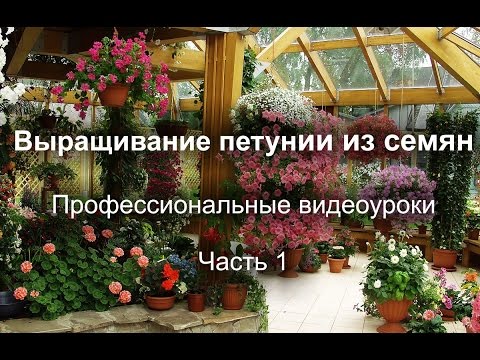

Watch this video on YouTube
Planting petunias in open ground
What time to plant
Loamy or sandy loamy fertile soil is suitable for growing petunias, and it will be very good if humus or compost is introduced into it before planting the plants. Fertilizing the soil with manure is not recommended, because fungal diseases can develop due to it.For planting, choose a well-lit open area. It is necessary to plant seedlings in the spring when there is no threat of recurrent frosts (as a rule, from mid to late May). Disembarkation should be done in the evening or on a rainy day.
Landing features
When planting flowering seedlings, the flowering of such a petunia will last until November. Since these flowers are most often low, they are planted along the edge of the flower bed. Flowers in pots first need to be watered very abundantly, then they are pulled out along with a lump of earth and planted in a previously prepared hole. Leave 0.3 to 0.4 m of free space between the plants. The planted flowers need to be watered. A day later, the surface of the site is covered with a layer of mulch.


Watch this video on YouTube
Caring for petunia in the garden
It is not too difficult to grow petunia, but before you start planting it, you need to study all the rules and features of caring for such a plant. Petunia is drought tolerant, but it must be watered during hot summer months. It should be noted that small-flowered varieties are less demanding for watering, compared to large-flowered varieties. During watering, water must be poured at the root, since otherwise very delicate flowers of the plant can be injured. After the petunia has been watered, the next day it is necessary to loosen the surface of the site, while removing all the weeds.
If you want flowering to be long-lasting and as effective as possible, systematically feed this plant. The first feeding of petunias is carried out 7 days after planting in open soil. Then feeding is carried out every week and a half until August, using a complex fertilizer, which contains a large amount of potassium. Occasionally, petunia can be fed with organic fertilizers, for example, humic fertilizers or mullein infusion.
Reproduction of petunia by cuttings
Propagation by cuttings is suitable only for terry and ampel petunias, and also for all varieties of mini-petunias (calibrachoa). Terry varieties can be propagated by cuttings in the last weeks of winter, the first - in spring, while mini-petunias and ampelous - all year round, but for this they need additional lighting with fluorescent lamps, as well as heat (from 21 to 24 degrees).
Cut off the apical cuttings, which should have 4 to 6 leaf blades. Tear off all the leaves except the top two. The remaining leaves should be shortened by ½ part. Cuttings must be planted for rooting in the same soil mixture that is used for seedlings. However, in this case the surface of the substrate should be covered with a layer of perlite or sand 20–25 mm thick, which must be spilled with a fungicide solution. A distance of 15–20 mm must be kept between the cuttings, and the container is covered with glass on top. It is unnecessary to use means that stimulate growth (for example, Heteroauxin), because freshly cut cuttings root well, but you should not delay planting them. The substrate in the greenhouse should be slightly damp all the time; for this, the petunia needs to be moistened with a spray bottle twice a day. However, it should be borne in mind that excessive dampness contributes to the development of "black leg" or mold. Terry and ampel petunia will fully take root after about 7 days, and mini petunia after 14 days.
After the length of the roots reaches 10-15 mm in length, the plant should be planted in individual pots, the diameter of which should be equal to 50 mm. In order for the plants to bush harder, they must be pinched over a 4 or 5 leaf plate. The tops of the stems remaining after the pinching can be used as cuttings. After half a month, if necessary, re-pinch the stems. After 6 weeks, these plants are transplanted into pots, the diameter of which reaches 11-13 centimeters. It is necessary to care for growing cuttings in almost the same way as for seedlings.However, it should be borne in mind that ampelous petunias and mini-petunias require a lot of free space, in this regard, it is recommended to hang containers with them.
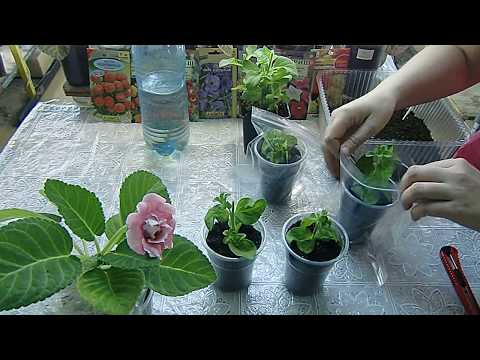

Watch this video on YouTube
Diseases and pests
If, when growing petunia, you follow all the rules of agricultural technology of such a crop, then it will never get sick, and harmful insects will not settle on it. If you take care of the plant incorrectly, then it sometimes gets sick with late blight, chlorosis, black leg and gray rot. To combat these diseases, you need to use funds specially designed for this. However, it is better to prevent the development of diseases, for this you just need to properly care for the bushes. Also, this plant can infect viral diseases, which today are considered incurable.
Aphids, thrips, spider mites and slugs can settle on petunias. In order to get rid of them, you should also use drugs specially designed for this.
Seed collection
Seeds should be collected only after they are fully ripe on the bush. During the flowering period, the bushes of those varieties from which you will need to collect seeds should be noted. It should be noted that the lower buds are used to collect seeds, because in them the seeds form and ripen faster. After the bud is fully formed, it should be noted for 8 weeks, after this time the seeds in them will fully ripen. The seeds of such a plant are small (about half a millimeter in diameter), there are about 100 of them in one box.
Shake out the ripe seeds from the pods and distribute them in bags, do not forget to sign the harvest year, variety and color of the flower. Alternatively, you can simply cut the boxes and store them at home. The seeds need to be ripened, for this they are stored for 3-4 months at room temperature. If stored correctly, the seeds remain viable for up to four years.
After flowering
If you want to save petunia, then it should be removed from the soil in October, then all shoots are removed from the bush. The bush is planted in a pot and removed to a cool room. Here the flower will rest, but it needs to be watered occasionally so that the earth is moderately moist. The pot with the plant must be transferred to a well-lit, warm windowsill in February, while systematic watering must be resumed. After 2 or 3 pairs of leaf plates are formed in young stems, they must be cut off with a "heel", which are planted in flowerpots filled with nutritious soil, its surface must be covered with a layer of sand. The container must be covered using glass or film, then it is transferred to a small shade. Provide the plants with regular watering, spraying, and airing for 20 days while the shoots are rooting. Then the plant is transplanted into separate cups. They are planted in open soil at the same time as petunia seedlings.
Unnecessary faded petunia bushes in autumn should be dug up and burned, and the site should be dug up.
Types and varieties of petunias with photos and names
All varieties of garden petunia are divided into 2 groups: large-flowered and multi-flowered.
Multiflorous petunias (multiflora)
Compared to large-flowered varieties, multiflora (multiflora) begin to bloom earlier, while many flowers with a five-centimeter diameter grow on the bush, they bloom for a relatively long time. Such flowers are not picky, they can be grown in any soil, they are not afraid of rains and they like sunlight. In this regard, such a petunia can be called a real garden flower. It looks less impressive than plants of large-flowered varieties, but compact bushes covered with flowers of various shades are able to delight with their beauty before the onset of severe frosts. The most popular are the following varieties of multiflorous petunia:
- Fantasy... This series consists of 9 hybrids.The height, as well as the diameter of the plants, is about 0.2 m, the flowers reach 40 mm in diameter, they can be colored: red with veins and a whitish throat, salmon, raspberry red, pale salmon with dark veins, raspberry pink, blue -violet, white, pale pink with a creamy throat, etc.
- Mirage... This series consists of 13 compact hybrids. The diameter of double flowers is from 60 to 90 mm, they can be colored: pink with dark pink veins, red with burgundy veins, crimson-burgundy, lilac-pink with purple veins, pink with crimson-red veins, white, etc.
- Plum Crystals... The bush reaches a height of about 0.3 m, and in diameter - 0.25 m.The diameter of its flowers is about 70 mm. Gradually, the color of the flowers fades: at first it is lilac-pink, then pale lilac, and in the end it is only slightly lilac. The burgundy-purple veins stand out against the flower.
Large-flowered petunia (grandiflora)
The most common group of hybrids, which includes hundreds of varieties, is the large-flowered petunia (grandiflora). Such plants have very large and showy flowers, but there are much fewer of them than on small-flowered bushes. Such a group has one drawback, the fact that the wind and rain can injure the flowers, which, because of this, lose their attractiveness. In this regard, large-flowered petunia, as a rule, is used for growing in containers or pots indoors, on a terrace or balcony. This group is divided into subgroups:
- large-flowered - the bush reaches a height of about 0.6 m, smooth flowers have a diameter of 8 to 10 centimeters;
- large-flowered low - the height of the bush is from 0.25 to 0.3 m, other characteristics are similar to the previous subgroup;
- large-flowered fringed low and large-flowered fringed - bushes reach a height of 0.25–0.3 m and 0.65–0.7 m, respectively, flowers are fringed, their diameter is about 12 centimeters;
- large-flowered superb low and large-flowered superb - the height of the bushes is 0.3–0.4 m and 0.5–0.75 m, respectively, smooth flowers have a wide pharynx, their diameter is about 10–12 centimeters, on the surface there are veins of a darker color compared to the main background;
- large-flowered terry - the height of the bush is from 0.5 to 0.6 m, large double flowers reach from 10 to 12 centimeters in diameter, their edge is fringed or smooth.
The following series of large-flowered petunias are very popular:
- Hit parade... These hybrids are fast flowering. The height of the bush is about 0.25 m.The flowers can be painted in a variety of colors, for example: crimson, blue with a white star, violet-blue, pink, white, salmon, etc.
- Pikoti... This series includes 4 hybrids, which differ in that they have strongly corrugated edges of the petals, which are surrounded by a white border, reaching a width of 15 mm. The bush reaches a height of 0.25 m. The flowers are purple, violet-blue, red, pink and crimson.
- Pearl pirouette... This terry hybrid of purple-violet color, along the fringed edge of the corrugated petals of which there is a white border. The bush reaches a height of 0.25 m.
Petunia floribunda
In addition to these most popular groups of petunias, petunia floribunda is still quite in demand. It occupies an intermediate position between these groups. For the flowers of this group, the rains are practically not terrible, almost as much as for the flowers of the multiflorous petunia. However, in order for such plants to look very beautiful, they must be grown in bulk, for this they are planted in large flower beds. Varieties:
- Sonia... This series is very popular with gardeners, it includes 11 hybrids. Bushes reach a height of 0.25 m.Flowers can be colored in crimson, burgundy-crimson with a whitish star, white, pale purple with purple veins, pink, pink-crimson with a whitish star, red with a whitish border, red, etc. ...
- Celebrity... This series includes hybrids that are resistant to heat and rain.Such a variety series has thirteen different colors, flowers are two-color, one-color or three-color.
Garden group of petunias
There is also a garden group called ampelous or balcony petunias. The plants included in it have flexible and long shoots that tend to grow downward. These flowers are fast growing and resistant to adverse weather conditions. Popular variety series:
- Surfinia... Flowers of these plants reach 60–90 mm in diameter. However, the miniature varieties included in the composition (Mini Pearl and Pink Mini) have flowers with a diameter of only 5 mm. Flowers can be painted in all possible color shades, except for deep yellow and orange.
- Tumbelina... This series is the result of the work of the Japanese company Suntory. Terry flowers.
- Conchita... The flowers of these hybrids are more similar in size and shape to the flowers of mini-petunias (calibrachoa). Small flowers reach 50 mm in diameter, they have a variety of colors, and can be painted in a variety of color shades.


Watch this video on YouTube

